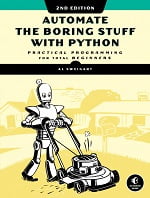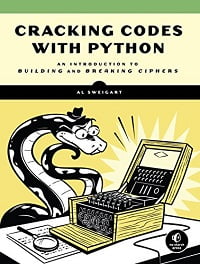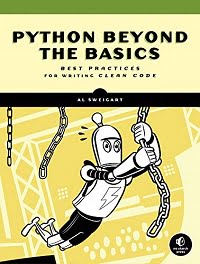This article reviews several Python Books by Al Sweigart.
Al Sweigart is a Python Influencer who has over the years created dozens of different Python resources, most notably books. In this article we’ll be exploring some of his most popular books that have been published. Many of these are highly reputed and widely read by many, so give them a read.
You can also check our article on “Recommended Python Books” for books by other authors.
Automate the Boring Stuff with Python (2nd)

- Published Date: November, 2019
- Level: No prior knowledge required
- Category: General Python + Libraries
‘Automate the Boring Stuff with Python’ is one of the Al Sweigart flagship books. It’s also the first Python book I ever read. This book was created with the intention of actually teaching people how to begin using python practically (in real life scenarios). Too many Python users only “know” python rather than actually use python outside of practice projects and examples. This book’s aim is to fix that.
‘Automate the Boring Stuff” is divided into two parts. The first section covers the core python concepts such as loops, functions, lists etc. This makes the book accessible to people who are completely new to Python. However, one thing to keep in mind is that this book does not cover Classes in order to focus more time on the python libraries and keep things simpler.
The second part of this book is it’s main focus and selling point. Though the book is divided in two, the second part is actually 3 times larger than the first due to how many libraries it covers.
The second part goes through over a dozen major libraries in Python. It does more than just introduce the library to you. It step by step takes you through full working examples, explaining each and every function and it’s use. Once you’ve grasped the basics, it then introduces a project (related to that library) for you to make and test your skills. Don’t worry, the book will help you along the way.
Some of the topics and libraries covered in this Book.
- Web Scraping – (BeautifulSoup)
- Regular Expressions – (re)
- Excel spreadsheets – (openpyxl)
- Keyboard and mouse automation – (pyautogui)
- Receiving and sending emails – (SMTP and IMAP)
And these aren’t even half of the total libraries in the book.
Invent Your Own Computer Games with Python

- Published Date: August, 2015
- Level: Beginner
- Category: Game Development
‘Invent your own Computer Games with Python’ is a book designed for beginners eager to begin developing games in python. Designing a game is isn’t easy and can often involve advanced concepts such as Gravity, Collision detection, Physics, random level generation etc. Instead of reading bits and pieces from online articles, it’s best to read a fully detailed book which takes you from start to finish.
Each chapter in the book gives you the complete source code for a game, and then teaches you the new programming concepts using the code as reference. Some of the many games included are ‘Guess the Number’, ‘Hangman’, ‘Tic Tac Toe’, and ‘Reversi’. The use of the game development library Pygame is also covered in this book.
Alternatively, you can check out a slightly more advanced version of this book by the Al Sweigart. It’s also about Game development and the same library (pygame), but significantly more detailed in regards to Pygame and covers many additional advanced topics. If you don’t mind a challenge, I highly recommend you read it instead.
Cracking Codes with Python

- Publish Date: January 2018
- Level: No prior knowledge required
- Category: Beginner
This book serves two purposes. One, it is a crash course on all the basic Python core concepts (Functions, Lists, Loops etc.) you need to qualify as a Python programmer. Secondly, this book is an introduction into the world of cryptography and ciphers.
Cracking Codes walks you through several different methods of encoding messages with different ciphers using the Python programming language. From a simple Caesar cipher all the way through an implementation of the textbook RSA cipher. You’ll see how various algorithmic strategies can be used against comparatively simple ciphers. The techniques include frequency analysis, word pattern matching and dictionary tests for decrypted text. All in all, everything you need to become a Junior cryptographer.
Even if you aren’t very particularly interested in cryptography or don’t need cryptography in the near future, I would still recommend you read this book. What this book will teach you, about codes, decryption and ciphers are all important in building a coder’s mindset. Such activities help develop your problem solving skills that will surely be useful when you’re programming and developing your own applications.
Python Beyond the Basics

- Publish Date: January 2018
- Level: Basic Python Knowledge required
- Category: Intermediate
This is one of Al Sweigart’s Python books that (unfortunately) doesn’t get enough attention. Most people simply read up on a Python books aimed towards beginners and stop learning after that. It’s not enough to just read one book, you need to follow up on that. This book is meant for that purpose. It’s a follow up book meant for people who have completed the Python Basics and want to know more.
Some of the aims of the book are mentioned below:
- Explanation of the complex terminology (jargon) used in programming.
- Learning how to write code that is readable to other programmers.
- Learning how to avoid common mistakes.
- Taking advantages of Python’s strengths and being aware of it’s weaknesses.
- Mastering object oriented programming and classes.
- Utilizing your new found skills in actual projects.
This marks the end of the Al Sweigart Python Books article. Any suggestions or contributions for CodersLegacy are more than welcome. Questions regarding the article content can be asked in the comments section below.

1 thought on “Python Books by Al Sweigart”